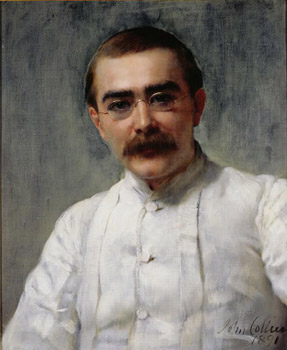 He was born in India (in Bombay), the
land where he began to write. It happened on December 30, 1865. His
parents were English. His father, professor of architectural sculpture,
was the Director of the Lahore Museum. So, the boy spent his early
childhood in Lahore. As a child Rudyard was quick to learn and alert in
games. Hindu servants adored the smart boy; they taught him their
language. From them he learned the picturesque tales and songs of Indian
folklore. At the age of six he and his sister were sent to England and
educated at an English College in North Devon.
He was born in India (in Bombay), the
land where he began to write. It happened on December 30, 1865. His
parents were English. His father, professor of architectural sculpture,
was the Director of the Lahore Museum. So, the boy spent his early
childhood in Lahore. As a child Rudyard was quick to learn and alert in
games. Hindu servants adored the smart boy; they taught him their
language. From them he learned the picturesque tales and songs of Indian
folklore. At the age of six he and his sister were sent to England and
educated at an English College in North Devon.
Moving back to India in 1882, he began his early career as a journalist. At seventeen he became sub-editor of the Lahore Civil and Military Gazette. At twenty one he published his first book of verse. Then ‘The Plain Tales from the Hills’ attracted public attention. Soon some other tales established his reputation as a master of fiction.
Kipling traveled around the world. When he returned to England in 1889, his reputation had preceded him, and within a year he was acclaimed as one of the most brilliant prose writers of his time.
He lived for a few years in America, where he married an American, Caroline Starr Balestier. There he wrote several of his most popular works. These were his stories for children, which became classics, ‘The Jungle Books’, ‘Captain Courageous’ and ‘Just so Stories’.
In 1907 he became the first English writer to receive the Nobel Prize for literature.
He continued to publish collections of short stories for adults throughout the rest of his life.
The charm of his stories is in the exciting plots, the variety of his subject matter and characters. As Somerset Maugham wrote: “He not only created characters, he created men. No one has made it more exciting, and no one has presented it so vividly and with such a wealth of color... He remains the best short-story writer England can boast of”.
A year after his death (he died on January 17, 1936) there appeared ‘Something of Myself’, a collection of autobiographical notes containing memoirs, and that ‘something’ about himself which Kipling was willing to disclose.
The Jungle Book
The Jungle book’ was written in 1894—95 in America. Since then, it’s been among the world’s most loved works for children. It is beautifully written. Each chapter begins with a poem and ends with a song. The characters are wild animals and a human being.
Mowgli is the child of an Indian wood-cutter. He got lost in the jungle. A female wolf becomes his mother. She lets him feed together with her cubs. The wolves don’t attack the child. They name him Mowgli. That means frog, as he is as naked as a frog.
Mowgli has a lot of friends, and among them are Akela, the leader of the pack, Baloo, the bear who taught him the Law of the Jungle, Bagheera, the black panther who guarded him from danger. Mowgli’s enemies are Shere Khan, the tiger, the jackal, the grey monkeys and the Red Dogs.
The code of conduct in the animal world is severe and requires a high level of responsibility. Mowgli has many adventures and they make him wise.
There comes a time when Mowgli, the grown-up, can fight a tiger without anyone’s help. He fights the Red Dogs. But he cannot fight his desire to live among human beings. And “Man goes to Man at last. though the Jungle does not cast him out.”
‘The Jungle Book’ shows that man is the weakest and at the same time the strongest animal in the world. It is his intellect that finally wins over nature.